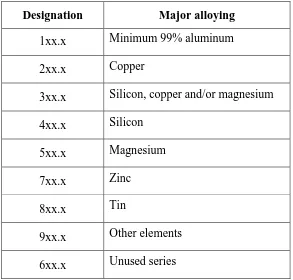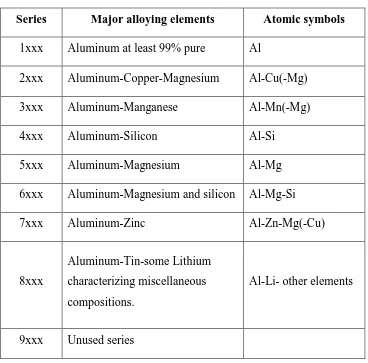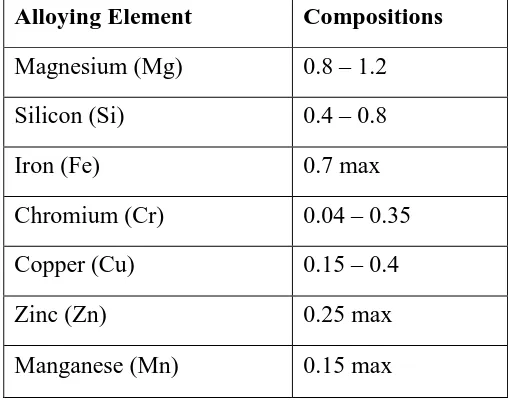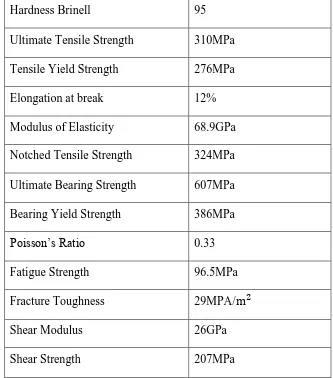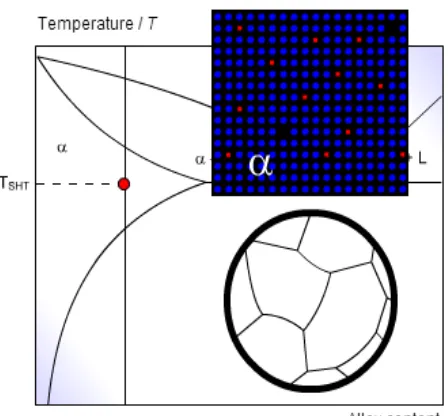UNIVERSITI TEKNIKAL MALAYSIA MELAKA
Effect of Heat Treatment Conditions on Aluminum Alloy 6061
This report submitted in accordance with requirement of the Universiti Teknikal
Malaysia Melaka (UTeM) for the Bachelor Degree of Manufacturing Engineering
(Manufacturing Process) (Hons.)
By
LEE MEI FANG B051010073 900928-13-6866
FACULTY OF MANUFACTURING ENGINEERING
DECLARATION
I hereby, declared this report entitled “Effect of Heat Treatment Conditions on
Aluninum Alloy 6061” is the results of my own research except as cited in
references.
Signature : ……….
Author’s Name : ………
APPROVAL
This report is submitted to the Faculty of Manufacturing Engineering of UTeM
as a partial fulfillment of the requirements for the degree of Bachelor of
Manufacturing Engineering (Process) (Hons.). The member of the supervisory is
as follow:
ABSTRAK
Laporan yang dibentangkan merupakan satu kajian eksperimen mengenai
pemendakan aloi aluninum 6061 untuk mengkaji kesan penuaan masa dan suhu
terhadap sifat mekanikal dan mikrostruktur. Rawatan haba telah digunakan untuk spesimen aluminium yang terdiri daripada proses rawatan haba pada 530 ˚ C diikuti oleh pelindapkejutan air dan akhirnya proses penuaan tiruan. Kajian eksperimen
tertumpu kepada penuaan tiruan di mana suhu penuaan yang berbeza-beza antara 150 ˚ C hingga 200 ˚ C pada lima kali penuaan yang berbeza. Vickers ujian kekerasan dan tegangan ujian adalah untuk menilai ukuran kekerasan dan kekuatan tegangan
untuk AA6061 masing-masing dan juga analisis mikrostruktur selepas proses
penuaan. Pelbagai suhu penuaan dan masa penuaan menunjukkan perbezaan yang
luar biasa dalam sifat mekanik dan pemerhatian mikroskopik. Masa penuaan
optimum dan suhu telah ditentukan pada akhir eksperimen ini. Kajian ini membawa
kepada kesimpulan bahawa optimum telah dicapai antara 150 ˚ C hingga 200 ˚ C
dengan 2 hingga 6 jam penuaan masa. Kesan rawatan haba ke atas kekuatan dan
kekerasan telah dikenalpastikan. Mikrostruktur analisis evolusi terhadap AA6061
ABSTRACT
The report presented an experimental study on the precipitation of aluninum alloy
6061 to investigate the effect of aging time and temperatures on the mechanical
properties and microstructure. Thermal treatment was applied to the aluminum specimens that included of heat treatment process at 530˚C; followed by water quenching and finally the artificial aging process. This experimental study was
focused on the artificial aging upon which the aging temperature is varying between 150˚C to 200˚C at five different aging times. The Vickers hardness test and tensile test were applied to evaluate the hardness measurements and tensile strength for
AA6061 respectively as well as the microstructure analysis after the aging process.
Various aging temperature and aging times indicated remarkable difference in the
mechanical properties and microscopic observation. The optimum aging time and
temperature was determined at the end of this experiment. The study brought to the conclusion that the optimum aged was achieved between 150˚C to 200˚C with 2 to 6 hours of aging time. The effect of heat treatment on the strength and hardness were
DEDICATION
To my beloved father Mr. Lee Hong Seng and mother Mdm. Christina Kueh, my
beloved eldest sister Ms. Lee Mei Fung, my beloved younger sister Ms. Lee Mei Ing,
my beloved younger brother Mr. Lee Yong Kiat and my respected Dr. Nur Izan
ACKNOWLEDGEMENT
I would like to express my utmost gratitude to Dr. Nur Izan Syahriah binti Hussein
for her all time guidance and supervision upon the execution of my project as project
supervisor. I would like to thank Ms. Lee Mei Fung and Mr. Tony Chen Wei Keat
for their greatest support and guidance as senior and mentor, as well as the helpful
laboratory technicians Mr. Sarman Bin Basri, Mr. Azhar Shah Bin Abu Hassan and
Mr. Safarizal Bin Madon. Credits also go to my graduated seniors Ms. Tan Kae Shin
CHAPTER 4: RESULTS AND DISCUSSION 34
4.1 Tensile Test 34
4.2 Hardness Test 42
4.3 Microstructure Analysis 49
4.4 Summary 55
CHAPTER 5: CONCLUSION AND FUTURE WORKS 56
5.1 Conclusion 56
5.2 Future Works 58
REFERENCES 59
LIST OF TABLES
2.1 Aluminum Alloy Designation for Cast Alloy 6
2.2 Aluminum Alloy Designation for Wrought Alloy 7
2.3 Nominal Composition of AA6061 8
2.4 Mechanical Properties of AA6061 8
2.5 Basic Temper Designations 14
2.6 Subdivision of T Temper: Thermally Treated 15
3.1 Artificial Aging with Aging Duration 27
3.2 Sheet-Type Specimen Dimension According To ASTM B557M 28
4.1 Summary of Tensile Strength AA6061 35
LIST OF FIGURES
4.1 Graph of the tensile strength versus aging time for aging temperature at 35
150˚C, 165˚C, 175˚C, 185˚C and 200˚C 4.2 Graph of tensile strength versus aging time 36
4.3 Graph of the tensile strength versus aging time for aging temperature at 37
165˚C
4.5 Graph of the tensile strength versus aging time for aging temperature at 39
175˚C
4.6 Graph of the tensile strength versus aging time for aging temperature at 40
185˚C
4.7 Graph of the tensile strength versus aging time for aging temperature at 41
200˚C
4.15 Graph of hardness versus aging time for aging temperature of 200˚C 48
4.16 Microstructure in age hardening heat treatment 49
4.17 Microstructure of AA6061–T6 50
4.18 Micro hardness and microstructure analysis of selected aging times at 51
185˚C, (a) as-received specimen, (b) after 2 hours, (c) after 3 hours,
(d) after 4 hours, (e) after 5 hours and (f) after 6 hours aging. X10
4.19 Effect of microstructure on strength and hardness 52
4.20 Microstructure analysis of aging time at 185˚C for as-received, 2 hours 53
aging and 3 hours aging
4.21 Microstructure analysis of aging time at 185˚C for 4 hours aging, 54
LIST OF ABBREVIATIONS, SYMBOLS AND
NOMENCLATURES
Al - Aluminum
AA6061 - Aluminum Alloy 6061
AA - Aluminum Association
ASM - American Society for Metal
SHT - Solution Heat Treatment
WQ - Water Quenching
TEM - Transmission Electron Microscopy
APFIM - Atom Probe Field Ion Microscopy
DOE - Design of Experiment
RSM - Respond Surface Methodology
UTM - Universal Testing Machine
ASTM - American Society of Testing and Material
GP - Guinier-Preston
SSS - Supersaturated Solid Solution
Mg₂Si - Magnesium Silicide
Mg - Magnesium
Si - Silicon
CHAPTER 1
INTRODUCTION
This report described the study on the effect of heat treatment on Aluminum Alloy
6061. Besides, factors that give impact on the heat treatment such as the temperature
and time approaching the testing specimens were discussed in this report. The
research background and problem statements were briefed in this chapter.
Furthermore, the objectives as well as the scope for the study are elaborated.
1.1 Background
Nowadays, companies have to face competition that becomes harder and severe
especially in the manufacturing industries. All industries are continuously striving to
establish the new goals in order to enhance their process organization and
management efficiency. In this competitive environment, industries have to identify
the best solution to fulfill their customers’ demands and satisfaction. Throughout the
industrial revolution era, heat treatment is one of the most innovative concept
represent a significant opportunity in today manufacturing industry for better
mechanical properties and microstructure evolution of the metals. The main function
of this heat treatment is to alter the physical and chemical properties by controlled
the heating as well as the cooling of the metals without the interrupt of product shape.
Heat treatment is an extraordinary step in the process of manufacturing that the end
results can be different by altering the procedure involved in the process or the type
of heat treatment. Essentially the properties of all materials can be enhanced through
The 6000 series group contains magnesium and silicon as major addition elements.
Due to the technological importance, the 6061 Al alloy has been studied extensively.
6061Al alloy mostly used as extruded products, construction and automotive
industries (Mohammad, 2011). This alloy can be easily shaped; its good density,
corrosion and surface properties as well as the better weldability are the outstanding
factors that along with economical price make this alloy highly demanded (Evren et
al., 2011: Mapellia et al., 2011).
1.2 Problem Statement
Heat treatment is the process involving controlled heating and cooling operations
towards materials in a way as to bring about a desired change in specific condition or
properties. There are some reasons for heat treating such as to remove stresses, to
refine the grain structure and other purposes as well. Even though heat treatment is a
useful technology which has been used widely but there are some disadvantages
which could lead to the imperfection of producing the products. Rajan (2012)
mentioned that oxidation, corrosion, fatigue and fracture are examples for the
metallurgical phenomena where imperfections take place. Variance conditions of
heat treatment such that the temperature, time and cooling method gives different
effect to the mechanical properties and microstructure evolution of the specific
material. Study of the effect of heat treatment on Aluminum Alloy 6061 using
furnace was carried out to determine the effect of the different conditions of heat
treatment in the respective of the temperature, time, and also the method of cooling
on Aluminum Alloy 6061. In addition, the result of the study was analyzed to verify
the differences between the constraints on the mechanical properties and
microstructure evolution of the Aluminum Alloy 6061.
1.3 Objective of Study
i. Study the heat treatment condition for AA6061.
ii. Study the effect of heat treatment condition to the microstructure,
strength and hardness of the AA6061.
iii. Propose the optimum heat treatment condition for AA6061 to achieve
ideal strength and hardness.
1.4 Scope of Study
The scope of this work is to perform review of the temperature and time for the heat
treatment of AA6061. The study was more focus on the parameters that contribute to
the effect of heat treatment towards the aluminum alloy properties. To accomplish
this project and the technical report, the work planning was organized in respective
chapters.
Maisonnette et al. (2011) mentioned that 6061 aluminum was introduced to fulfill the
necessity for medium-strength heat-treatable aluminum which is tough but easily
welded and joined or anodized. It is the most versatile and least costing of
heat-treatable aluminum alloy and is applicable in which appearance and moderate
strength are required. Altering the mechanical properties by heat treatment, specific
mechanical strength was achieved. Aluminum alloys gain strength from the process
of solution heat-treating and aging.
1.5 Activity Planning
The activity planning throughout the weeks in these two semesters were summarized
CHAPTER 2
LITERATURE REVIEW
This chapter demonstrated the theoretical concepts and information in engineering
field which are related to this study. Types of Aluminum Alloy, heat treatment and
microstructure investigation were described in this chapter. Besides, the type of
cooling method for the heat treatment was explained. Next, the parameters that give
impact on the AA6061 series were discussed. Consequently, the mechanical testing
for the Aluminum Alloy after the heat treatment was presented. Last but not least,
this chapter ended with a brief summary.
2.1 Aluminum Alloy
An alloy is the combination of two or more metals which consists of specific
desirable characteristics that include the corrosion resistance, strength and
formability (Aluminum Association 2009). Aluminum (Al) acts as the predominant
metal in aluminum alloys. Copper, magnesium, zinc, silicon and manganese are the
typical alloying elements in aluminum alloys. Aluminum alloys are widely used in
daily lives either in products or applications, from the small size aluminum can for
beverages to the huge structure of the aircraft. Aluminum alloys are broadly used in
engineering components and structures in which the characteristic of corrosion
2.1.1 Aluminum Alloy Designation
Basically, aluminum alloys are categorized into two major types that are cast alloys
and wrought alloys. The Aluminum Association designates three-digit system for
cast alloys which followed by a decimal value and four-digit system for wrought
alloys. Cast alloys are the aluminum alloys that are poured as a liquid into a mold
and cooled into a solid shape. In Aluminum Association (AA), the minimum
percentage of aluminum is reveal by the second two digits. The main alloying
elements in the AA system are described in Table 2.1.
Table 2.1: Aluminum Alloy Designation for Cast Alloy (Aluminum Association Inc, 2009)
Designation Major alloying
The identification system of wrought alloys consists of four digit numbers which the
first number represents the type of alloy, the second number represents the control
over impurities, and the last two numbers normally represents the specific alloys.
are the non-heat treatable alloys that cannot be strengthened through heat treatment.
The alloys from this group are ductile and moderately strong that depend on the
alloying element concentration. Heat-treatable alloys included the series of 2xxx,
6xxx and 7xxx which can be strengthened by heat treatment.
Table 2.2: Aluminum Alloy Designation for Wrought Alloy (Aluminum Association Inc, 2009)
Series Major alloying elements Atomic symbols
1xxx Aluminum at least 99% pure Al
approach is taken to dissolve the alloying elements, and then quench to achieve super
saturation and finally age hardening to precipitate solute atoms either at room
2.1.2 Aluminum Alloy 6061
Aluminum alloy 6000 series is an aluminum alloy that majorly consists of alloying
elements of magnesium and silicon. AA6061 is the least costly and most versatile
among the heat-treatable aluminum alloys. This alloy has the most of the good
quality of aluminum which it offers a range of superior mechanical properties and
good corrosion resistance. As one of the most generally used heat-treatable
aluminum alloys, 6061 is available in various range of structural shapes, and also
sheet and plate products. AA6061 is widely used in variety of products and
applications from truck bodies and frames to screw machine parts and structural
components. Table 2.3 shows the nominal composition for AA6061.
Table 2.3: Nominal Composition of AA6061 (Aluminum Association Inc, 2009)
Alloying Element Compositions
Magnesium (Mg) 0.8 – 1.2
Silicon (Si) 0.4 – 0.8
Iron (Fe) 0.7 max
Chromium (Cr) 0.04 – 0.35
Copper (Cu) 0.15 – 0.4
Zinc (Zn) 0.25 max
Table 2.4: Mechanical properties of AA 6061 (Source Aluminum Association Inc, 2000)
Melting point is important in order to make the study safe and success. Heating the
material without knowing its melting point may cause the specimen melts or no
effect at all. AA6061 has the melting point in the range of 582-652˚C (Aluminum
Association Inc, 2006).
2.2 Heat Treatment in Aluminum Alloy
Heat treatment is a combination or any one of the series of operations that including
alter their mechanical properties from the specification of strength and hardness can
be obviously raised by heat treatment. Most of the heat-treatable alloys contain the
combinations of magnesium with either one or more of the elements zinc, copper and
silicon (ASM Handbook, 1996). The heat treatment process for 6000 series, although
not as strong as the 2000 series and 7000 series but it has good weldability,
formability and machinability and corrosion resistance, with medium strength (ASM
Handbook, 1996).
Heat treatment of aluminum alloys is three successive steps:
i. Solution heat treatment : dissolution of soluble phases
ii. Quenching : development of supersaturation
iii. Age hardening : precipitation of solute atoms either in room temperature (nature aging) or at elevated temperature up to 200˚C (artificial aging or precipitation heat treatment)
2.2.1 Solution Heat Treatment
Solution heat treatment is the ability to heat the alloy to a temperature range in which
the solute is totally dissolved (Chandler, 1996). It is compulsory to produce a solid
solution in order to take advantage of the precipitation hardening reaction. The
purpose of this process is to take into solid solution the maximum practical amounts
of the soluble hardening elements on the alloy. Figure 2.1 demonstrates the phase
diagram of temperature against alloy content. All of the alloys of the constituents are
Figure 2.1: Phase Diagram of Alloy (Aluminum Matter Inc, 2010)
In order to achieve a nearly homogeneous solid solution, the soaking process of alloy
is done at a sufficiently high temperature and for a long time. Air is the usual heating
medium; however, molten salt baths or fluidized beds are outstanding in providing
more rapid heating.
This process is carried out under controlled conditions that to avoid exceeding the
eutectic melting temperature. Overheating in solution heat treatment may degrade the
properties such as fracture toughness, tensile and ductility. When the underheating
occurs in the alloy that being heat treated are obviously below the normal range,
solution is somehow incomplete and the strength lower than normal is expected
(ASM Handbook ,1996).
The soaking time is vital for a satisfactory degree of solution of the undissolved or
precipitated soluble phase constituents and to obtain good homogeneity of the solid
solution (Evran 2003). Time required for solution heat treatment comply with the
product type, alloy, prior history and section thickness. Heating time is controlled by
the section thickness. The time consumed to heat a load to the treatment temperature
in furnace heat treatment increases together along with the section thickness and,
